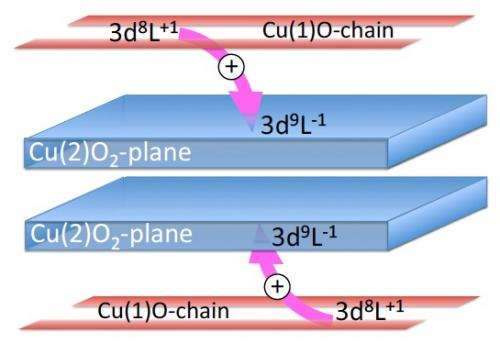Self-doping may be the key to superconductivity in room temperature

Swedish materials researchers at Linköping and Uppsala University and Chalmers University of Technology, in collaboration with researchers at the Swiss Synchrotron Light Source (SLS) in Switzerland investigated the superconductor YBa2Cu3O7-x (abbreviated YBCO) using advanced X-ray spectroscopy.
Their findings are published in the Nature journal Science Reports.
YBCO is a well-known ceramic copper-based material that can conduct electricity without loss (superconductivity) when it is cooled below its critical temperature Tc=-183° C. Since the resistance and energy losses are zero in superconductors, there exist many technologically interesting and energy-saving electrical applications as well as benefits to the transport industry. Electromagnets in electric motors can be made smaller with stronger magnetic fields that are more powerful yet consume less energy; magnetic levitating trains that exploit superconductor technology can reach higher speeds by avoiding friction against rails.
On the other hand, the necessity of cooling these materials to low temperatures remains to be an obstacle one would like to eliminate. Therefore, one of the major objectives of superconductor research is trying to find a material that is superconducting at room temperature. However, the mechanism that underlies high-temperature superconductivity is still not entirely understood. In this work, the researchers have made a discovery that may shed new light on this phenomenon. X-ray absorption spectroscopy (XAS) and resonant inelastic X-ray scattering (RIXS) was used for measuring YBCO at room temperature and at -258° C, which is far below Tc.
What makes YBCO special as a superconductor is that it is made up of two types of structural units, i.e. stacked "planes" of copper oxide, assumed to carry the superconducting current, but also separate "chains" of copper oxide in between. The role of the chains in YBCO has puzzled scientists ever since the discovery of its superconducting properties in 1987. One had realized early on that Tc can be influenced in the material synthesis procedure by varying the "oxygen doping", and thus the length of the chains.
It has long been assumed that the doping level of the material was solely determined by the structure of the chains at the time of synthesis. By contrast, the new experimental results show that the chains in YBCO react to cooling by supplying the copper oxide planes with positive charge (electron-hole), a mechanism called self-doping. By combining RIXS and model calculations, the researchers also found that self-doping is accompanied by changes in the copper-oxygen bonds that link the planes with the chains.
This groundbreaking discovery of self doping in YBCO challenges the traditional understanding of the mechanism of superconductivity in copper-based high-temperature superconductors, which assumes a constant doping level in the copper oxide planes. Some previous temperature-dependent experiments will now have to be re-evaluated in this new light, and thereby help us come closer to finally solving the riddle of high temperature superconductivity. Next, the researchers plan to conduct a more detailed temperature dependent study to determine if restructuring and redistribution of the orbital occupation occurs exactly at the phase transition to superconductivity or if it already occurs at a higher temperature in the so-called pseudogap region.
More information: Self-doping processes between planes and chains in the metal-to-superconductor transition of YBa2Cu3O6.9; M. Magnuson, T. Schmitt, V.N. Strocov, J. Schlappa, A.S. Kalabukhov and L.-C. Duda; Scientific Reports 4, 717 (2014). DOI: 10.1038 / srep07017 , Published: November 12, 2014.
Journal information: Scientific Reports
Provided by Linköping University





















